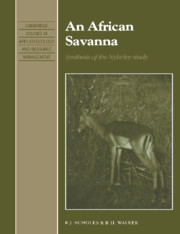Book contents
- Frontmatter
- Contents
- Preface
- I Nylsvley in an African savanna context
- II The key determinants: water, nutrients, fire and herbivory
- III The carbon cycle
- IV Community and landscape pattern and change
- 12 Rich savanna, poor savanna
- 13 Community structure, composition and dynamics
- 14 Tree–grass interactions
- 15 Plant–herbivore interactions
- Part V Lessons from Nylsvley
- Bibliography
- Index
14 - Tree–grass interactions
Published online by Cambridge University Press: 06 October 2009
- Frontmatter
- Contents
- Preface
- I Nylsvley in an African savanna context
- II The key determinants: water, nutrients, fire and herbivory
- III The carbon cycle
- IV Community and landscape pattern and change
- 12 Rich savanna, poor savanna
- 13 Community structure, composition and dynamics
- 14 Tree–grass interactions
- 15 Plant–herbivore interactions
- Part V Lessons from Nylsvley
- Bibliography
- Index
Summary
If the distinguishing feature of savannas is the co-dominance by trees and grasses, then the central question in savanna ecology must be the mechanism of their coexistence. The interaction between the woody component and the grass layer is a feature absent from either pure grasslands or closed woodlands. All biomes include a range of plants types; but savannas are unusual in that two functional types (‘trees’ and ‘grass’ for short), share the primary production in a more or less equitable fashion. Plants, lacking the mobility of animals, all use essentially the same resources: radiant energy, water and nutrients. Simple competition theory predicts that when competitors use the same resource, one should be superior to the other, and should become dominant. Trees and grasses have evolved very dissimilar patterns of environmental interaction. In large areas of the world either one or the other is dominant. What is special about the savanna environment that allows trees and grasses to coexist? This is the core of what Sarmiento (1984) calls the ‘savanna problem’.
The proportions of trees and grasses in a given savanna are not always predictable from environmental conditions, nor are they stable over time. On the same substrate and under the same climate there may be local variations in the proportions. Nevertheless, the large-scale, long-term pattern is one of a remarkably stable coexistence. An increase in woody plant density usually follows sustained heavy grazing.
- Type
- Chapter
- Information
- An African SavannaSynthesis of the Nylsvley Study, pp. 215 - 229Publisher: Cambridge University PressPrint publication year: 1993
- 2
- Cited by



